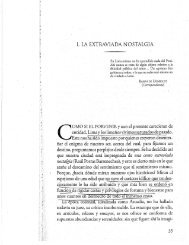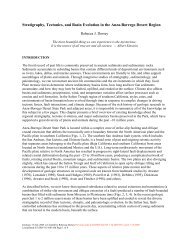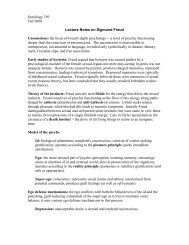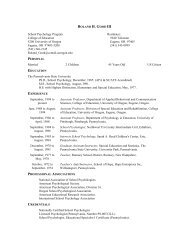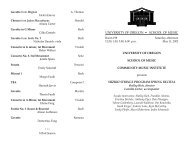Example : Suppose that, in a particular city, airport A handles 60% of ...
Example : Suppose that, in a particular city, airport A handles 60% of ...
Example : Suppose that, in a particular city, airport A handles 60% of ...
You also want an ePaper? Increase the reach of your titles
YUMPU automatically turns print PDFs into web optimized ePapers that Google loves.
HW MATH 461/561 Lecture Notes 18 1<br />
<strong>Example</strong> :<br />
<strong>Suppose</strong> <strong>that</strong>, <strong>in</strong> a <strong>particular</strong> <strong>city</strong>, <strong>airport</strong> A <strong>handles</strong> <strong>60%</strong> <strong>of</strong> all<br />
airl<strong>in</strong>e traffic, and <strong>airport</strong> B <strong>handles</strong> 40% <strong>of</strong> all airl<strong>in</strong>e traffic. The<br />
detection rates for weapons at the <strong>airport</strong>s A and B are 0.9 and<br />
0.8, respectively.<br />
(1) If a passenger at one <strong>of</strong> the <strong>airport</strong>s is found to be carry<strong>in</strong>g a<br />
weapon through the board<strong>in</strong>g gate, what is the probability <strong>that</strong><br />
the passenger is us<strong>in</strong>g <strong>airport</strong> A?<br />
(2) If 30 passengers at one <strong>of</strong> the <strong>airport</strong>s are found to be carry<strong>in</strong>g<br />
a weapon through the board<strong>in</strong>g gate and they are <strong>in</strong>dependent,<br />
what is the probability <strong>that</strong> at least 17 <strong>of</strong> them are us<strong>in</strong>g the<br />
<strong>airport</strong> A<br />
Solution:<br />
(1) Def<strong>in</strong>e<br />
A : passenger uses <strong>airport</strong> A.<br />
B : passenger uses <strong>airport</strong> B.<br />
D : a weapon is detected.<br />
Accord<strong>in</strong>g to the <strong>in</strong>formation, we have<br />
P(D|A) = 0.9, P(A) = 0.6, P(B) = 0.4, P(D|B) = 0.8<br />
By Bayes’ rule, we have<br />
P(A|D) =<br />
P(A)P(D|A)<br />
P(A)P(D|A) + P(B)P(D|B)<br />
= 0.627<br />
Let X be the number <strong>of</strong> passengers carry<strong>in</strong>g a weapon and us<strong>in</strong>g<br />
<strong>airport</strong> A. Accord<strong>in</strong>g to the <strong>in</strong>formation, the success probability<br />
p = 62.7%<br />
(I) np = 30(0.627) = 18.81 > 5 and nq = 30(0.373) = 11.19 > 5.<br />
(II) µ = np = 18.81, σ = √ npq = � 30(0.627)(0.373) = 2.648<br />
(III) The question is just to f<strong>in</strong>d the probability P(X ≥ 17). Ac-
HW MATH 461/561 Lecture Notes 18 2<br />
cord<strong>in</strong>g to (I), we have<br />
P(X ≥ a) = P(Z ≥<br />
a − 0.5 − np<br />
√ )<br />
npq<br />
P(X ≥ 17) = P(Z ≥ 17−0.5−18.81<br />
2.648 ) = P(Z ≥ −0.872)<br />
= P(−∞ ≤ Z ≤ 0.872) = 0.8078<br />
Start<strong>in</strong>g from this chapter, we beg<strong>in</strong> to talk about statistics.<br />
In statistics, we <strong>of</strong>ten need to f<strong>in</strong>d a probability distribution<br />
to fit the observed data distribution. Then, we can make <strong>in</strong>ference<br />
about the random experiment. One typical problem <strong>of</strong><br />
such k<strong>in</strong>d is <strong>that</strong> we know for sure <strong>that</strong> the data has one distribution,<br />
but we don’t know the parameters <strong>of</strong> the distribution.<br />
For example, we know <strong>that</strong> the data has normal distribution<br />
N(µ, σ). However, we don’t know what are the µ and<br />
σ. An obvious way is us<strong>in</strong>g the data to estimate them. Now,<br />
we discuss one popular parameter estimation method which is<br />
called Maximum Likelihood estimation. Before discuss<strong>in</strong>g this<br />
method, we need to <strong>in</strong>troduce some basic def<strong>in</strong>itions.<br />
Def<strong>in</strong>ition: A sequence <strong>of</strong> <strong>in</strong>dependent rv’s X1, · · · , Xn which are<br />
def<strong>in</strong>ed on a common probability space (Ω, P) and they have identical<br />
distribution is called a random sample <strong>of</strong> size n. An outcome<br />
or observation <strong>of</strong> X1, · · · , Xn, denoted by x1, · · · , xn, is called<br />
a sample outcome or simply a sample.<br />
<strong>Example</strong>: Consider an experiment <strong>of</strong> flipp<strong>in</strong>g a fair co<strong>in</strong> 5 times.<br />
Def<strong>in</strong>e<br />
Xi =<br />
⎧<br />
⎨<br />
1 if observ<strong>in</strong>g head at the i th flipp<strong>in</strong>g<br />
⎩<br />
0 if observ<strong>in</strong>g tail at the ith flipp<strong>in</strong>g
HW MATH 461/561 Lecture Notes 18 3<br />
Then, X1, · · · , X5 is a random sample. 1, 0, 0, 1, 1 is a sample outcome.<br />
In order to be easier to understand the idea. Let us start by a<br />
simple example which can show the idea clearly.<br />
<strong>Example</strong>: In a box, there are 100 balls which are identical except<br />
their colors. Each ball has either white color or black color. We<br />
know <strong>that</strong> 99 balls have same color and the rest one ball has a<br />
different color. However, we don’t know which color the 99 balls<br />
have. Now, we randomly draw a ball. If the observed ball is<br />
white, can you guess which color the 99 balls have? Why?<br />
Solution: Certa<strong>in</strong>ly we will guess <strong>that</strong> the 99 balls have white<br />
color. The reason is as follows: If <strong>in</strong> the box there are 99 white<br />
balls and only one black ball, the probability <strong>of</strong> draw<strong>in</strong>g a white<br />
ball is much bigger than the probability <strong>of</strong> draw<strong>in</strong>g a black ball.<br />
In other words, a white ball has much bigger chance to be drawn.<br />
Inversely, observed one should have bigger chance to be drawn.<br />
Thus, we should f<strong>in</strong>d the estimator(s) <strong>of</strong> the parameter(s) such<br />
<strong>that</strong> the sample outcomes have biggest probability to be observed.<br />
This is just the basic idea <strong>of</strong> the maximum likelihood<br />
estimation.<br />
Def<strong>in</strong>ition: Let X1, · · · , Xn be a random sample from f(x, θ), where<br />
θ is an unknown parameter. The likelihood function, L(θ), is def<strong>in</strong>ed<br />
as follows:<br />
n�<br />
L(θ) = f(xi, θ)<br />
i=1<br />
where x1, · · · , xn is the sample outcomes. Thus, maximum likelihood<br />
method is to f<strong>in</strong>d a ˆ θ which maximizes L(θ). The ˆ θ is called<br />
the estimator <strong>of</strong> parameter θ.<br />
<strong>Example</strong>: In a random experiment <strong>that</strong> a biased co<strong>in</strong> is flipped
HW MATH 461/561 Lecture Notes 18 4<br />
n times. The outcomes is (k1, · · · , kn), where<br />
⎧<br />
⎨ 1 If a head was observed <strong>in</strong> the i<br />
ki =<br />
⎩<br />
th flipp<strong>in</strong>g<br />
0 If a tail was observed <strong>in</strong> the ith flipp<strong>in</strong>g<br />
Estimate p, the probability <strong>of</strong> observ<strong>in</strong>g a head by the MLE.<br />
Solution:Def<strong>in</strong>e<br />
⎧<br />
⎨ 1 If a head comes up <strong>in</strong> the i<br />
Xi =<br />
⎩<br />
th flipp<strong>in</strong>g<br />
0 If a tail comes up <strong>in</strong> the ith flipp<strong>in</strong>g<br />
Note <strong>that</strong> p is the probability <strong>of</strong> observ<strong>in</strong>g a head. Thus,<br />
P(X1 = k1, · · · , Xn = kn) = p k1(1 − p) (1−k1) · · · p kn (1 − p) (1−kn)<br />
= p k (1 − p) (n−k) ,<br />
where k = � n<br />
i=1 ki. S<strong>in</strong>ce observed should have biggest probability,<br />
we should f<strong>in</strong>d p such <strong>that</strong> P(X1 = k1, · · · , Xn = kn) is<br />
maximized. To this purpose, from calculus, we know <strong>that</strong> the<br />
maximum po<strong>in</strong>t is the ones such <strong>that</strong> the derivative is equal to<br />
zero.<br />
d<br />
dp [pk (1 − p) (n−k) ] = k[p (k−1) (1 − p) (n−k) ] + (k − n)[p k (1 − p) (n−k−1)<br />
This equation can be reduced to<br />
k(1 − p) + (k − n)p = 0<br />
which has solution k/n. Thus, we should use k/n to estimate the<br />
parameter p.<br />
Remark: We know <strong>that</strong> f(p) = p k (1 − p) (n−k) atta<strong>in</strong>s its maximum<br />
at p0 if and only if ln f(p) atta<strong>in</strong>s its maximum at p0. S<strong>in</strong>ce<br />
d<br />
dp ln[pk (1 − p) (n−k) ] = k<br />
p<br />
− n − k<br />
1 − p
HW MATH 461/561 Lecture Notes 18 5<br />
and<br />
d2 dp2 ln[pk (1 − p) (n−k) ] = − k n − k<br />
− ≤ 0.<br />
p2 (1 − p) 2<br />
Set<br />
d<br />
dp ln[pk (1 − p) (n−k) ] = 0.<br />
We get p = k/n. By calculus, f(p) atta<strong>in</strong>s its maximum at p0 =<br />
k/n.<br />
<strong>Example</strong>: Consider a problem <strong>of</strong> estimation <strong>of</strong> total number <strong>of</strong><br />
fish, say n, <strong>in</strong> a lake. Design a strategy, then us<strong>in</strong>g the maximum<br />
likelihood method to estimate n.<br />
Solution: We randomly catch 200 fish. After mark<strong>in</strong>g each fish,<br />
we return all fish to the lake. After one day, we catch fish 100<br />
times successively with replacement. We found <strong>that</strong> there are 1<br />
fish with the marks and 99 without the marks. S<strong>in</strong>ce there are<br />
200 fish with marks, the probability to catch a marked fish is<br />
200/n. This is a b<strong>in</strong>omial experiment with successive probability<br />
p = 200/n and failure probability 1 − p. The probability <strong>that</strong><br />
catch<strong>in</strong>g 100 times, there are 1 marked fish is<br />
C 100<br />
1 p 1 (1 − p) 100−1 = C 100<br />
1 p(1 − p) 99<br />
Accord<strong>in</strong>g the idea <strong>of</strong> maximum likelihood estimation, we should<br />
f<strong>in</strong>d n or p which maximizes the probability<br />
C 100<br />
1 p(1 − p) 99<br />
or p maximizes f(p) := p(1 − p) 99 . Let<br />
we get<br />
d<br />
dp f(p) = (1 − p)99 − 99p(1 − p) 98 = 0<br />
(1 − p) 99 = 99p(1 − p) 98
HW MATH 461/561 Lecture Notes 18 6<br />
or 1 − p = 99p. Thus, p = 1/100 and n = 20, 000.





